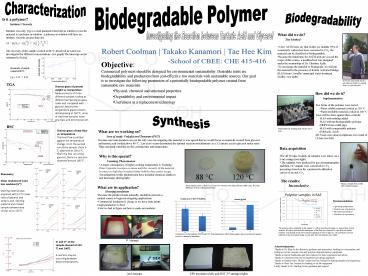Biodegradable Polymer - PowerPoint PPT Presentation
1 / 1
Title:
Biodegradable Polymer
Description:
Thanks to Dr. Skip for his direction, guidance and instruction, lending us a viscometer, and letting us use the vacuum oven and polymer characterization equipment – PowerPoint PPT presentation
Number of Views:145
Avg rating:3.0/5.0
Title: Biodegradable Polymer
1
Characterization
Biodegradable Polymer
Biodegradability
Is it a polymer? Intrinsic Viscosity Intrinsic
viscosity, ?, is a vital parameter that tells
us whether or not the material is a polymer in
solution. A polymer in solution will have an
intrinsic viscosity greater than one The
viscosity of the sample cooked at 88 C dissolved
in water was investigated for different
concentrations. (see graph) The intercept can be
estimated to be ?.
Investigating the Reaction between Tartaric Acid
and Glycerol
- What did we do?
- Test Method
- A few ASTM tests say that if after six months 70
of a materials carbon has been converted to CO2,
the material can be classified as biodegradable - Because the timeframe for ASTM tests are exceed
the scope of this course, a modified test was
designed under the mentorship of Dr. Christine
Kelly. - To encourage the material to biodegrade, we will
put the material in the presence of Return
Activated Sludge (RAS) from Corvallis municipal
water treatment facility. (see right)
Robert Coolman Takako Kanamori Tae Hee Kim
-School of CBEE CHE 415-416
- Objective
- Commercial polymers should be designed for
environmental sustainability. Desirable traits
are biodegradability and production from
cost-effective raw materials with sustainable
sources. Our goal is to investigate the following
parameters of a potentially biodegradable polymer
created from sustainable raw materials - Physical, chemical and structural properties
- Degradability and environmental impact
- Usefulness as a replacement technology
Viscometry of sample cooked at 88 0C. ? 1.27
0.11
Its brown and smelly, but its not what you
think it is. Really folks, its just microbes.
TGA
Thermo-gram of percent weight vs.
temperature Measurements of three different
samples cooked at different temperatures were
made and compared with glycerol. Around the
temperature glycerol starts decomposing at 160
0C, none of the three samples loose any mass and
decompose yet.
- How did we do it?
- Implementation
- Two forms of the polymer were tested
- Water soluble material cooked at 120 C
- Water insoluble material cooked at 140 C
- Tests will be done against three controls
- RAS with nothing added
- RAS with un-biodegradable polymer (HDPE from a
milk jug) - RAS with compostable polymer
- (Polylactic Acid)
- All 5 tests were done in triplicate, for a total
of 15 runs (see left)
Synthesis
DSC
Shake flask tray holding what will be our 15 runs.
Thermo-gram of heat flow vs. temperature The heat
flow is plotted against the temperature change.
From the second run of the sample, there is Tg
observed at 100.6 0C. From the first run of the
glycerol, there is a reaction observed around 180
0C.
What are we working on? Area of study
Polyglycerol Tartarate (PGT) Because our team
members are not the only ones investigating this
material, it was agreed that we would focus on
materials created from glycerol and tartaric acid
cooked above 80 C. Last years team determined
the optimal reaction stoichiometry as a 32
tartaric acid to glycerol molar ratio. Thus, our
main variables are the cooking time and
temperature.
- Data acquisition
- For all 15 runs, bi-daily air samples were taken
via a 1-ml syringe (see right) - The samples were analyzed by gas chromatographer
and then, GC outputs were converted to CO2
percentage based on the constructed calibration
curves of air and CO2
- Why is this special?
- Foaming Phenomenon
- A major consequence of higher cooking temperature
is foaming - Water byproduct escapes as steam until the
viscosity of the material becomes so high that it
instead forms bubbles that cannot escape - Investigations in this phenomenon have included
chemical additives and time-lapse photography
Rheometry Shear modulus (G) and loss modulus
(G) Starting material was prepared with (37.5
mass ratio of glycerol and tartaric acid.
Starting material and cooked sample behaves very
similar up to 120 0C.
The results Inconclusive
Taking a sample from a flask with modified stopper
- What are its application?
- Housing insulation
- Because the product foams naturally, insulation
presents a natural course to begin investigating
applications - Commercial insulation is cheap, so we have some
pretty tough parameters to beat. - First we had to figure out how to make an
insulator
Recommendations
- Operating temperature
- Particle size of polymers
- Measurement method
- Duration of experiment
The percent carbon originally in the sample vs.
carbon dioxide percentage vs. elapsed time. In
this analysis, all carbon dioxide in the head
space of the flask was assumed to come from the
added polymer, even though it may have instead
originated as yeast or glucose. CB, polylactic
acid was added in to the pre-treated sludge a
week after other test batches were added.
1st Attempt
G and G of the sample sheared at 120 0C and
1400C. A reaction may be occurring between these
temperatures.
- Acknowledgements
- Thanks to Dr. Skip for his direction, guidance
and instruction, lending us a viscometer, and
letting us use the vacuum oven and polymer
characterization equipment - Thanks to David Hackleman and Don Jackson for
their experience and advice - Thanks to Christine Kelly for her expertise and
design ingenuity - Thanks to Heather Paris, Birdie Cornyn and Jan
Trinkel for sharing samples and experience - Thanks to Staci Van Norman for training us on lab
equipment - Lastly, thanks to Dr. Harding for his guidance
and support
2nd Attempt































